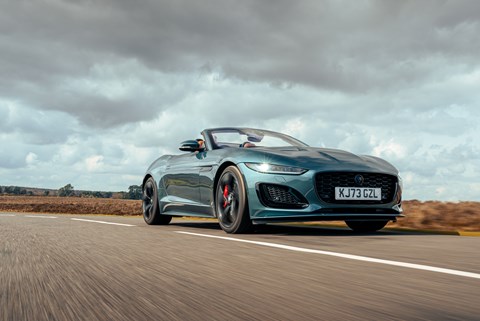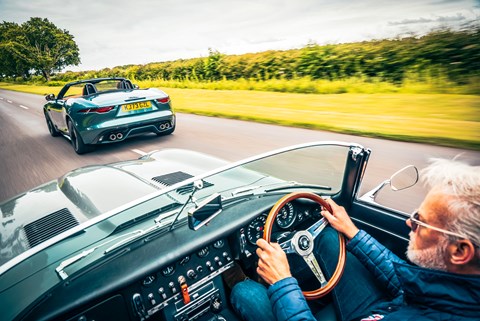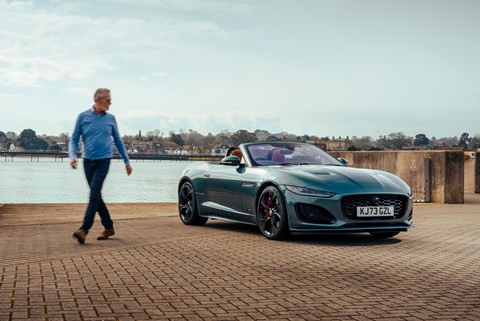► The end of our F-Type long-term loan
► We meet Eagle for a triumphant send-off
► Read month 5 here
Maybe I’m at that age when a powerful rocket scratches a specific itch. Maybe I’m a pushover for a car with an excess of swagger and poise. Whatever the reason, the Jaguar made an impact on my daily driving routine like few other test cars I’ve had the privilege of running. No matter how mundane the journey, the F-Type made it, and in turn me, feel special.
It’s the diametric opposite of the Volkswagen ID. 5 that it replaced in my life: the Jaguar’s laden with character and charm, its sumptuous cabin is a button-heavy, tech-light joy, and it’s equally adept at both long-range GT cruising and pacey cross-country blasts.

Fuel economy levelled out at a respectable (for a car with this performance) 25mpg over the course of the six months, nothing broke or stopped working, and the F-Type’s allure easily compensated for the very few minor irritations that did arise. A captivating car that every would-be Porsche 911 buyer should consider, although I suspect not many do.
The Jaguar marque has had what’s politely described as a chequered history, but this genuinely feels like a goodbye not just to a respected and much-loved model, but to an entire company as we know it. If the future of the Jaguar sports car is uncertain, maybe we should look to the past, and to the E-Type. No other car has left such an indelible mark on the automotive consciousness as the F-Type’s predecessor.
And no one knows this true icon better than Paul Brace, head of Eagle E-Types. At its treasure-trove Sussex base, he and founder Henry Pearman have been successfully re-manufacturing the E-Type to modern-day standards to the delight of owners wanting reliability and durability alongside knuckle-biting sexiness.
‘Compared to the F-Type, the E-Type had two factors on its side. It had very little competition and it wasn’t produced in huge numbers. It led and others followed,’ says Brace.

‘The F-Type faced much stiffer competition, and was produced in relatively high numbers. So 50 years from now will we be as captivated with the F-Type as we are today with the E-Type?’ Brace pauses for a beat. I’m expecting a polite but emphatic ‘no’; however, that’s not what I get.
‘The F-Type has a huge amount going for it. The more I look at them, the more I like them. Jaguar has correctly let its proportions, stance and attitude do the talking – it hasn’t loaded it with fussy detailing. When a car’s proportions are spot-on,’ he nods appreciatively at the E-Type, ‘and detailing is kept to a minimum, the car looks better over time.’ Brace also points out the F-Type’s performance, its lack of intrusive driver aids and its analogue driver-centric focus, all of which are likely to bolster its future status.
Just over half a century separates the debut of the E-Type in 1961 and the arrival of the F-Type in 2013, but visually and dynamically they are twins. Sure, parked up alongside one another the F-Type is strikingly bigger, but they mirror each other’s snouty looks and their shared proportions are even more pronounced from the cockpits, with the front-hinged bonnets pointing the way.

On the move, their dynamics confirm this common lineage. From their snug set-back driver’s seat both roadsters feel muscular and taut, surging forward the second your right foot thinks about moving. They typify that Jaguar trait of feeling keyed into the road while breathing smoothly over it. I revel in the E-Type’s composed ride, the perfect weighting of its controls, the chatty steering, and the confidence it provides to start sewing together corners and straights. It’s as wonderful to drive as it is to pore over.
I hope that 50 years hence the next generation of engineers at Eagle will be wheeling out F-Types that turn heads and generate grins. It deserves nothing less.
Read month 5
Read month 4
Read month 3
Read month 2
Read month 1
Logbook: Jaguar F-Type 75
Price £84,125 (£88,145 as tested)
Performance 5000cc V8, 450bhp, 4.4sec 0-62mph, 177mph
Efficiency 27.0mpg (official), 24.9mpg (tested), 238g/km CO2
Energy cost 26.0p per mile
Miles this month 973
Total miles 4863
Count the cost
Cost new £88,145
Part-exchange £61,835
Cost per mile 26.0p
Cost per mile including depreciation £5.41